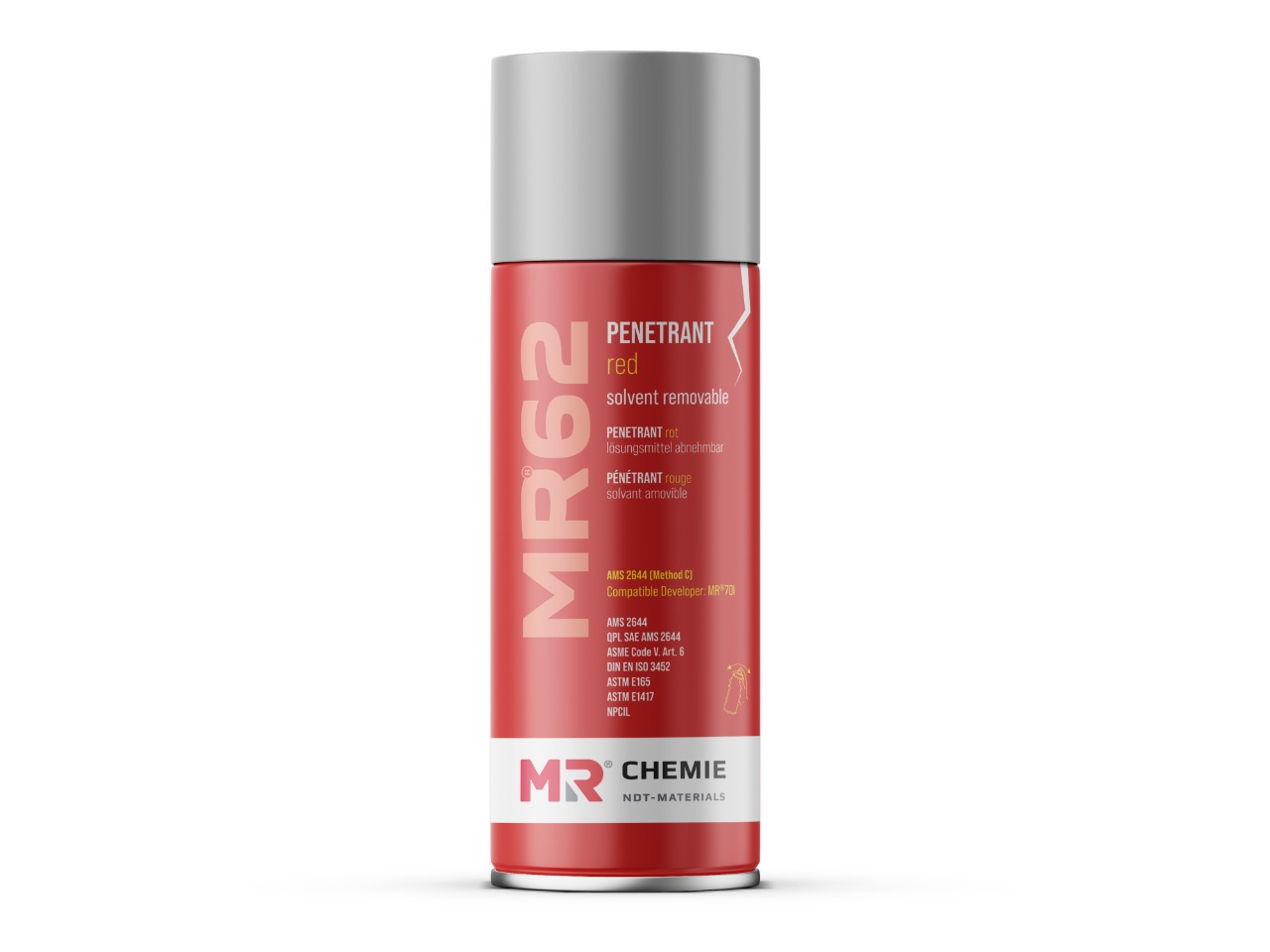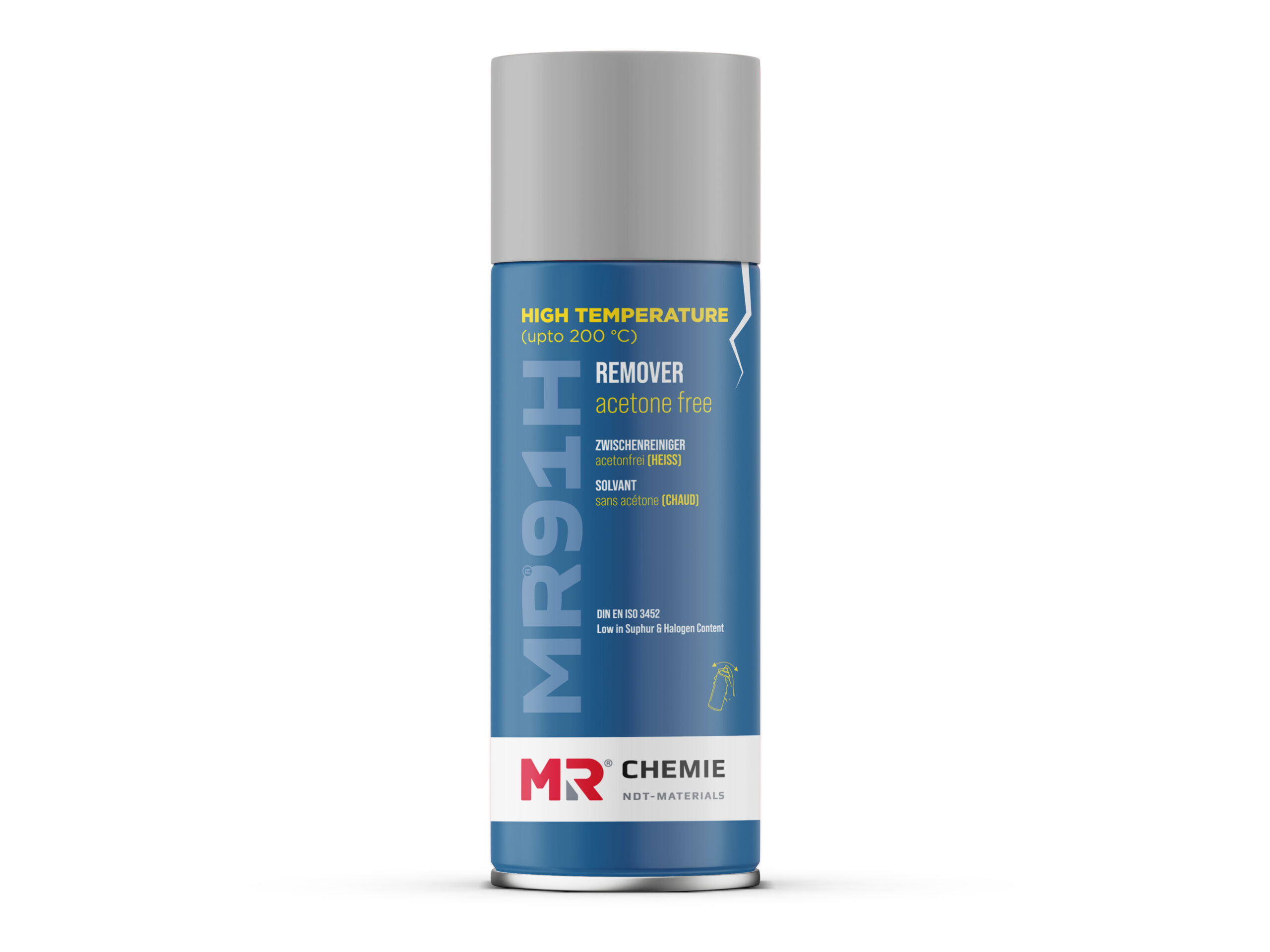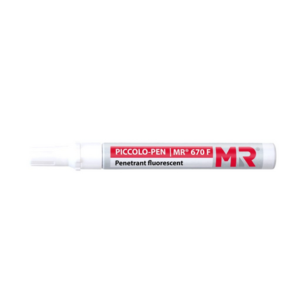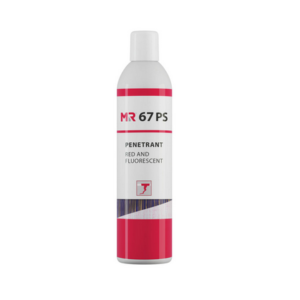MR®91H, Cleaner ‘hot’ (high temperature ≤ 200°C)
MR®91H is a NDT-approved non-halogenated hydrocarbon-based cleaner/remover for pre-cleaning (removes oils, greases and other contaminants) and removing excess surface penetrant from an inspection area before applying developer during during dye-penetrant inspection for high temperature applications upto 200°C. It dries quickly without leaving any residue on the surface.
| SKU | Pack Size | Case Size |
| 2511-0162 | Aerosol 400ml | 10 |
Additional information
| Properties | Appearance – clear liquid |
|---|---|
| Approvals | ASME Code V, Art. 6 |
| Family Testing | Penetrant – MR68H |
| Recommended Usage | NDT Method – Dye Penetrant Testing for high temperature |
| Reference Test Blocks | Reference test block type 1 (Ni-Cr panel – 20µm, 30µm & 50µm) |
Features
- hydrocarbon based
- Non halogenated cleaner
- Residue free
- Suitable for use at low temperatures
- Fast dry
- Controlled application
- Non toxic
- Does not overclean
- Suitable for all metals (suitability for plastics & ceramics requires testing prior to use)
- High temperature stability
- No smoke
How it Works
There are different types of cleaners used in NDT, such as solvent cleaners, emulsion cleaners, and aqueous cleaners. Solvent cleaners are typically used for removing oily or greasy contaminants, while emulsion cleaners are used for removing both oily and non-oily contaminants. Aqueous cleaners are water-based and are typically used for cleaning sensitive materials that cannot tolerate solvent cleaners.
Pre-Cleaners in NDT are used to remove contaminants such as oil, grease, dirt, and other foreign materials from the surface of the material being inspected. They work by breaking down the chemical bonds between the contaminants and the surface of the material, allowing them to be easily removed.
Intermediate Cleaners in NDT are used to remove the excess penetrant from the surface while retaining the penetrant inside the discontinuity. This is achieved by ensuring the special solvent mixture; when applied on the substrate cleans the excess penetrant on the surface and optimally dries without cleaning the penetrant seeped in the discontinuity.
GHS
Aerosol UN Model Regulation - UN 1950 AEROSOLS, 2.1FAQ
Q: What is high temperature penetrant testing?
A: High temperature penetrant testing is a non-destructive testing (NDT) method used to detect surface-breaking defects in materials that will be exposed to high temperatures. This testing technique uses a penetrant material that can withstand high temperatures, typically up to 392°F (200°C), and is ideal for use in applications such as aerospace, power generation, and automotive industries.
Q: What are the advantages of high temperature penetrant testing?
A: The advantages of high temperature penetrant testing include the ability to detect surface-breaking defects in materials that will be exposed to high temperatures, the ability to perform inspections without damaging the material being tested, and the ability to identify potential issues before they become more serious.
Q: What are the limitations of high-temperature penetrant testing?
A: The limitations of high temperature penetrant testing include the need for specialized equipment and trained personnel.
Q: What is the procedure for high temperature penetrant testing?
A: The procedure for high temperature penetrant testing typically involves surface preparation, penetrant application, excess penetrant removal, developer application and inspection. The specific procedure will depend on the material being inspected and the specific application.
Q: Can high temperature penetrant testing be used on all materials?
A: High temperature penetrant testing can be used on a wide range of materials, including metals, ceramics, and composites. However, the specific material being tested and the specific application may require the use of specialized penetrants and developers.
Q: What safety precautions should be taken during high temperature penetrant testing?
A: Safety precautions during high temperature penetrant testing include the use of personal protective equipment (PPE) such as heat-resistant gloves and goggles, the proper handling and disposal of chemicals, and the adherence to safety guidelines outlined in the NDT procedure.






